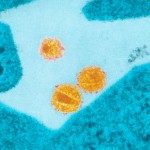Lien vers Pubmed [PMID] – 1319717
AIDS 1992 Apr;6(4):399-406
DESIGN: The study of the early and late stages of encephalopathy following infection by the feline immunodeficiency virus (FIV) was carried out with laboratory and naturally infected cats.
INTERVENTIONS: Animals infected experimentally were injected with three different isolates of the virus, administered either intracerebrally or intravenously, and sacrificed at 7 days, 1 and 6 months (intracerebral injection), and 2, 6 and 12 months (intravenous injection) post-inoculation, respectively.
CONCLUSIONS: General features of encephalopathy were found to be identical, regardless of the method of inoculation or the viral strain used. Moderate gliosis and glial nodules, sometimes associated with perivascular infiltrates and white matter pallor, were observed at 1 month (intracerebral injection) and 2 months (intravenous injection), and remained unchanged until 12 months post-inoculation. The fact that these initial stages are identical for intravenously and intracerebrally inoculated cats suggests that the virus enters the brain very quickly in intravenously infected animals. Encephalopathy in cats naturally infected with FIV only consisted of gliosis, glial nodules, white matter pallor, meningeal perivascular calcification and meningitis. These lesions were more frequent and more severe in the group coinfected with feline leukaemia virus and feline infectious peritonitis virus. Although multinucleated cells were rare, the strong similarities between HIV and simian immunodeficiency virus encephalopathies at comparable stages support the view that FIV infection may represent an interesting model for a physiopathological approach of HIV infection of the central nervous system.
